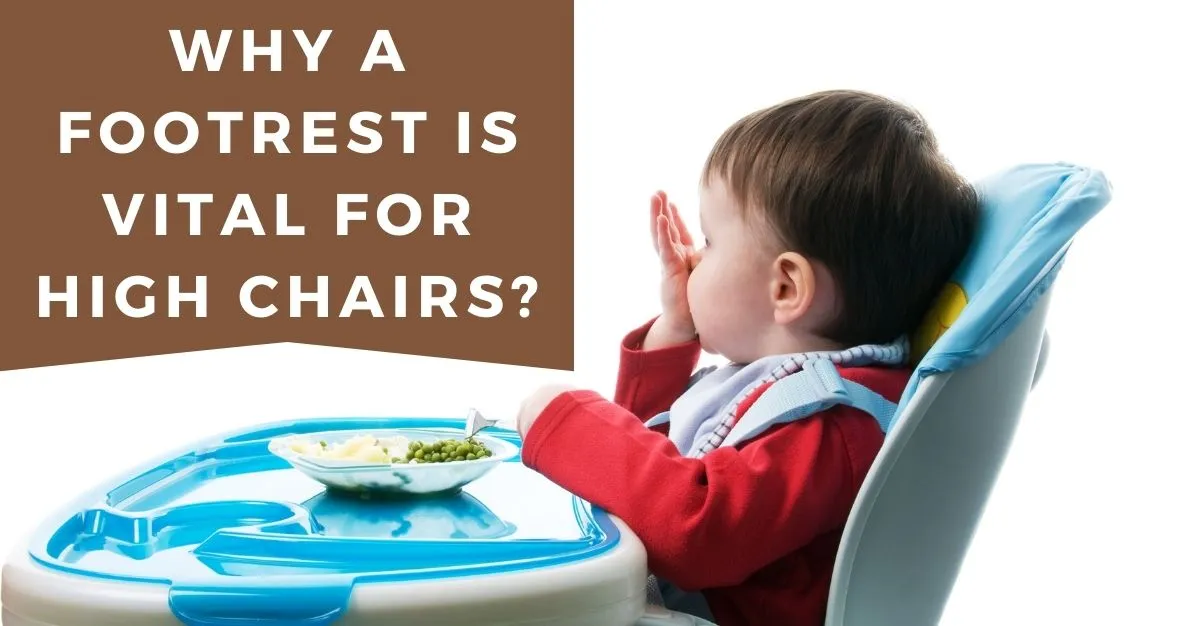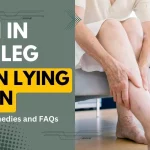If you take care of young children, you might understand how important a high chair is for their well-being. It ensures a safe and secure space for your little ones to sit and enjoy meals or engage in activities. However, are you aware of a footrest’s crucial role in a high chair? Although it may seem minor, a footrest can significantly influence your child’s comfort, posture and overall well-being.
In this article, we’ll explore why is a footrest important for high chair and its many benefits. We’ll also discuss the different types of footrests, features to look for when choosing one and how to use and maintain it correctly. Whether you’re a new parent or an experienced caregiver, this article will provide valuable insights into the importance of a footrest in a high chair.
Anatomy of a High Chair
When choosing a high chair for your child, it’s essential to understand the various parts that make up the chair. The main components of a high chair include the seat, tray, harness, legs and footrest. The seat is where your child will sit, and it should be comfortable and have appropriate cushioning. The tray is specially designed to hold food and various items, making it effortless for your child to reach them during mealtime. The harness is essential for ensuring your child’s Safety and keeping them securely in place while sitting in the chair. Finally, the legs provide stability and support for the chair.
The footrest is an often overlooked component of a high chair, but it is crucial for promoting good posture and overall comfort for your child. A footrest provides a place for your child’s feet to rest comfortably, which helps to prevent slouching and promotes healthy spinal alignment. It also allows your child to sit more naturally, improving circulation and digestion. The footrest also helps to provide a sense of security for your child, giving them a place to rest their feet and feel more grounded in their seat. Overall, the footrest plays an essential role in the overall design of a high chair and it should be noticed when choosing a chair for your child.
Benefits of Using a Footrest
Using a footrest with a high chair can provide numerous benefits for your child. One of the most significant benefits is improved posture. A footrest helps to prevent slouching, which can cause discomfort and pain in the back and neck. In addition, allowing your child’s feet to rest comfortably encourages them to sit up straight and maintain a healthy spinal alignment.
Another benefit of using a footrest is increased comfort. With their feet supported, your child can sit more comfortably for extended periods, whether eating or participating in other activities. A footrest also helps to reduce fidgeting and encourages your child to stay focused during mealtimes or other activities.
Using a footrest can also improve circulation and digestion. By elevating their feet slightly, a footrest can help to reduce pressure on the legs and promote better blood flow. This can also aid digestion by encouraging a more natural sitting position and allowing food to move quickly through the digestive system.
Impact of Lack of Footrest
The lack of a high chair footrest can negatively impact your child’s comfort, health, and overall well-being. One of the most significant effects of not having a footrest is on posture. Without a footrest, your child’s feet will dangle, which can cause them to slouch and develop poor posture. This can cause discomfort, pain and potential long-term health issues.
The absence of a footrest can also lead to discomfort for your child. With no place to rest their feet, your child may become fidgety and restless, which can cause discomfort and make mealtimes more challenging. This can also affect their overall health, as discomfort can cause stress and affect their mood and behavior.
Another significant effect of not having a footrest is on digestion. When a child’s feet are dangling, it can put pressure on their stomach, making it harder for food to pass through the digestive system. This can lead to indigestion, acid reflux and other digestive issues.
Types of Footrests
Three main types of footrests are available for high chairs: fixed, adjustable, and removable.
Fixed footrests are attached to the high chair and cannot be adjusted. They are typically made of the same material as the high chair and provide a sturdy and stable base for your child’s feet. Fixed footrests are popular for parents who want a low-maintenance option for their high chair.
Adjustable footrests can be moved up and down to accommodate different heights and ages of children. They often have multiple height settings and may also have an adjustable angle for optimal comfort. Adjustable footrests are a versatile option for growing with your child and providing customized support.
Removable footrests are designed to be easily attached and detached from the high chair. In addition, they can be taken off when not needed, making them an excellent option for parents who want flexibility and convenience. Removable footrests can also be adjusted to different heights and angles for optimal comfort.
Features of a Good Footrest
When it comes to selecting a footrest for your high chair, there are several features that you should consider to ensure you choose a good one. These include:
Size: The footrest should be appropriately sized for your child’s feet and height, so they can comfortably rest on it.
Durability: The footrest should be made of durable materials that can withstand frequent use and last long.
Ease of Adjustment: If you choose an adjustable footrest, it should be easy to adjust to the desired height and angle.
Material Quality: The footrest should be made of high-quality materials that are safe for your child to use and easy to clean.
Safety Features: The footrest should have safety features such as non-slip surfaces and secure attachment mechanisms to prevent accidents and ensure your child’s Safety.
The Ideal Height of a Footrest
When selecting the ideal height for a footrest, there are general guidelines and factors to consider. Here are some key things to keep in mind:
General Guidelines for the Height of a Footrest: The footrest should be positioned at a height that allows your child’s feet to rest comfortably with their knees bent at a 90-degree angle. This helps to promote good posture and prevent slouching.
The Importance of Adjustability: Many footrests are adjustable, allowing you to customize the height and angle to your child’s needs. This is especially important as your child grows and their height and comfort level change.
Factors to Consider When Adjusting the Height of a Footrest: Consider your child’s height, the height of the high chair and their comfort level when adjusting the footrest height. Ensure the footrest is not too high or too low, which can cause discomfort or strain.
How to Use a Footrest
Using a footrest correctly can significantly improve your child’s feeding experience. Here are some tips on how to use a footrest:
Explanation of the Proper Use of a Footrest: A footrest should support your child’s feet and legs while they sit in the high chair. The footrest should be adjusted to a comfortable height and angle that allows your child to keep their feet flat and their knees at a 90-degree angle. This helps to promote good posture and prevent slouching.
Tips for Adjusting the Footrest:
- When adjusting the footrest, ensure it is secure and does not wobble or move.
- Adjust the height and angle based on your child’s comfort level and height.
- Ensure that the footrest is not too high or too low, which can cause discomfort or strain.
Common Mistakes to Avoid when Using a Footrest: One common mistake is placing the child’s feet on the footrest before securing the tray or straps. Always secure the tray and straps before adjusting the footrest. Another mistake is not adjusting the footrest to the correct height, leading to discomfort and poor posture.
Maintenance of a Footrest
Footrests must be regularly maintained to remain clean and safe to use. Here’s what you need to know:
Explanation of the Cleaning Process: Start by wiping down the footrest with a damp cloth to remove any food or debris. You can use a mild soap solution and a soft-bristled brush to scrub the footrest for a deeper clean. Make sure to rinse thoroughly and dry completely before use.
Tips for Maintaining a Footrest:
- Avoid harsh chemicals or abrasive cleaners that can damage the footrest’s surface.
- Regularly inspect the footrest for any signs of wear and tear, such as cracks or sharp edges, and replace it if necessary.
- Store the footrest in a clean, dry place when not in use to prevent dust and debris buildup.
Common Mistakes to Avoid when Maintaining a Footrest: One common mistake is not cleaning the footrest regularly, which can lead to a buildup of bacteria and germs. Another mistake is using a rough sponge or brush to scrub the footrest, which can cause scratches and damage to the surface.
Safety Considerations.
Safety should be a top priority when using a footrest for your child’s high chair. Here are some important safety considerations to keep in mind:
Importance of Safety when using a Footrest: A footrest that is not properly secured or adjusted can pose a safety risk to your child. Choosing a footrest designed with Safety in mind is important and using it correctly to ensure your child’s Safety.
Safety Features to Look for in a Footrest: Look for footrests with non-slip surfaces to prevent your child’s feet from slipping off. Some footrests also come with adjustable straps or hooks to securely attach the footrest to the high chair. It’s important to choose a footrest that is made of safe, non-toxic materials and meets safety standards.
Tips for Ensuring Safety when Using a Footrest:
- Always follow the manufacturer’s instructions for installing and using the footrest.
- Ensure the footrest is securely attached to the high chair and adjust it to the correct height for your child.
- Never leave your child unattended in the high chair; always supervise them while using the footrest.
Overall, using a footrest on a high chair has numerous benefits for infants and toddlers. It helps to improve posture, increase comfort, promote better circulation, aid digestion and reduce fussiness. Conversely, lack of a footrest can negatively impact these areas, leading to discomfort, poor posture and even potential health problems.
When choosing a footrest for a high chair, it is important to consider its size, durability, ease of adjustment, material quality, and Safety features. In addition, proper use of a footrest and maintenance are crucial for ensuring its longevity and Safety. In summary, using a footrest in a high chair is a simple yet effective way to promote children’s health and well-being. Therefore, we encourage all parents and caregivers to incorporate it into their feeding routines.
Frequently Asked Questions (FAQs).
Do you need a footrest on a high chair?
A: While having a footrest on a high chair is unnecessary, it is highly recommended for the comfort and Safety of the child. A footrest supports the feet, improves posture, circulation and digestion and reduces fussiness.
Q: Why do high chairs have footrests?
A: High chairs have footrests to support the feet, improve posture, circulation, digestion, and reduce fussiness. Footrests also promote Safety by preventing the child from sliding forward out of the chair.
Q: How can I make my high chair more supportive?
A: To make your high chair more supportive, consider purchasing a footrest if it does not come with one. Additionally, ensure that the chair is the correct height for your child and that the seat and backrest provide adequate support.
Q: Why do babies’ feet need to be supported while eating?
A: Babies’ feet must be supported while eating to promote proper posture, circulation, digestion and comfort. Additionally, foot support can prevent the child from sliding forward out of the chair and promote Safety.




1 thought on “Why is a Footrest Important for High Chair”